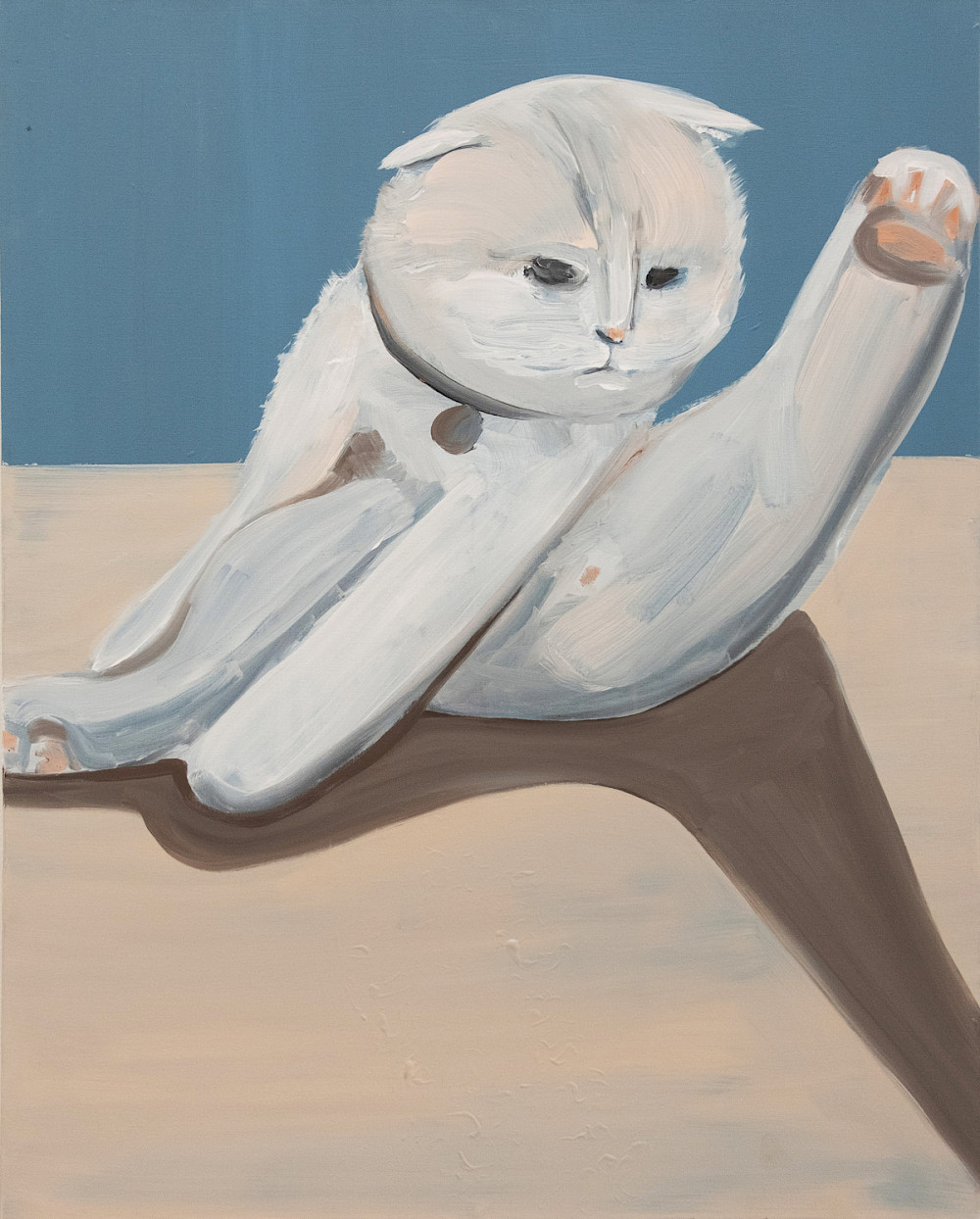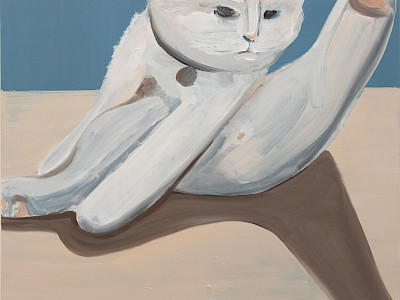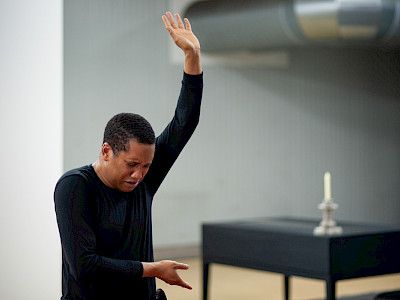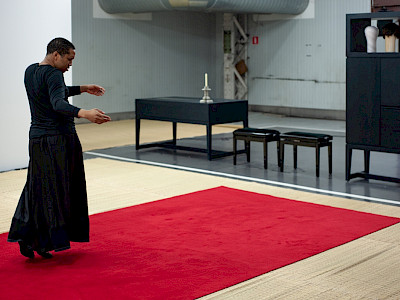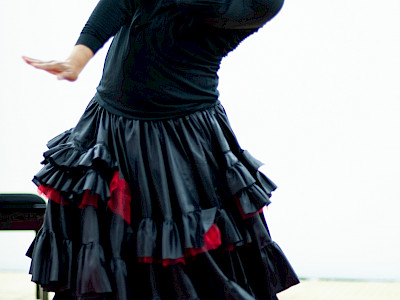10 — 12.05, 18.05, 19.05.2019
Trajal Harrell Athens / Zürich
Dancer of the Year
dance / performance / installation — premiere
⧖ 45min | € 20 / € 16
For his first appearance at the festival, Trajal Harrell presents his new creation, Dancer of the Year. In recent years the American dancer and choreographer has toured the world with a series of shows in which he brings together the postmodern dance of the white, artistic middle class with the voguing dance style practised by the African American and Latino LGBTQ communities. For the festival he ventures into a full-length solo project for the first time in a while. The point of departure is a personal one: Harrell’s nomination as ‘Dancer of the Year’ by Tanz magazine in 2018 and the reflection on (self)worth which this triggered. The project consists on the one hand of a reflective dance solo in which Harrell focuses attention on (self)representation. He confronts his singularity and aesthetic with the eponymous honorary title and reflects on what he means to dance and what dance means to him. On the one hand, Dancer of the Year is a dance, and on the other, a performative installation in the form of a shop where Harrell puts up for sale personal objects of inestimable value such as family heirlooms. Questions about origins and legacy, (self)worth and the valorization of art connect the dance solo with the installation. The influence of the Japanese butoh dance style and of choreographer Tatsumi Hijikata who asked his dancers to dance and work in nightclubs to gather money also makes itself felt.
Shop opening hours:
10.05 : 12:00—16:00 & 21:00—22:00
11.05 : 12:00—16:00 & 22:00—00:00
12.05 : 12:00—14:00
18.05 : 12:00—16:00
19.05 : 12:00—14:00
With a ticket for the performance, you have access to the Shop on the same day. Otherwise the Shop is accessible with a ticket of Kanal — Centre Pompidou.
On Trajal Harrell’s Dancer of the Year
In the dance solo, Dancer of the Year, we see Trajal Harrell repeating gestures (as if to store them in his body); revisiting movement material and choreographic strategies from previous work; and moving through and layering emotions. As the dance continues, he visibly exhausts himself. In an intimate setting, he shares his labor with us, offers his dance to us, as a gift. In the Dancer of the Year Shop, we may interact directly with Harrell, ask him to see an item on display from up close, take our time to view an object, touch it, and even purchase it, to take home. In their juxtaposition, these two performances raise questions about what exactly it is that the/a dancer is sharing/selling, about how we, as spectators, in turn, receive this work; and about the (material) value of dance.
Harrell created this work in response to being awarded the title of Dancer of the Year 2018 by Tanz magazine. The award leads him to question his status and identity as a dancer. What is the currency of this title? What is the value of dance, dance practice, and the knowledge it produces? What generates it? How does dance/the body internalize its history and how is it transmitted for the future? Harrell reflects on his own legacy as a choreographer/dancer, as he interrogates and re-imagines his artistic lineage, and the strategies he developed over the years for (re-)presenting and performing the self/identity.
Dancer of the Year is also the latest installment in Harrell’s current period of work, in which he engages with Japanese choreographer/dancer Tatsumi Hijikata (1928-1986), one of the originators of butoh, and fashion designer Rei Kawakubo (Comme des Garçons). Initially, only these two influential figures were marked on the “imaginary map” that animates this project, but this constellation has since been expanded to include many others, from Loïe Fuller to Sade. The project began with Used, Abused and Hung Out to Dry, presented at MoMA in New York in 2013, and was further developed during a residency at the museum. Each performance reflects on the circulation of Harrell’s work between the gallery and the theatre, and on the different conditions of creation, presentation, participation, and viewing these contexts represent.
Dancer of the Year and the Dancer of the Year Shop continue this trajectory. Like Caen Amour (2016), they juxtapose multiple modalities of showing/exhibiting and looking at objects and the body, to interrogate the status of dance as an “art object,” the body as “object,” and the role of both performer and spectator in this context. Harrell challenges the objecti-fication of the body on display, and foregrounds the labor of the dancer and his/her agency inside the work. He also questions the position of the spectator, who he requires to move, and whose movements he choreographs. Like Caen Amour, this work layers multiple spaces – from the theatre and the museum to the shop, the archive, and the home – and invites the spectator to circulate between them. We are invited to reflect on our own position, as we participate in one or both of the pieces, each with its own sense of distance/proximity (to the art and the artist), its own codes and rituals, and its own temporality.
The movement or circulation, itself, of the dancer and the dance, of the spectator, but also of the material of dance – the collection of ideas, references, inspiration, objects, costumes, experiences, gestures and actions that inform a performance – became an important element of Harrell’s current period of work. He works with diverse material to activate the imagination, and explores different ways to re-appropriate and re-purpose this material. Here, it is revealed and mobilized in yet another way. Harrell not only invites the spectator to step into his world, as it were, to view from up close and question what informs his dance and his thinking. Part of this private world of the dancer (potentially) also travels outside of the installation-performance, as objects are offered for sale. What happens to such an object when it is taken home, and/or enters into a public or private art collection, and enters into yet another economy?
In previous work, Harrell worked on dance history, to critically undo it, or to activate it differently, by means of what he calls the “historical imagination.” In the Twenty Looks or Paris is Burning at the Judson Church series, he problematized the discourse around American postmodern dance, for instance, by juxtaposing its minimalism with other modes of performativity, derived from the fashion catwalk and the voguing competitions at the Harlem Ballrooms. Harrell’s speculative history allows for other bodies, identities, and voices to become part of – and unsettle – the conven-tional narrative. His operations reveal hidden or under-theorized connections, across historical times, geographical distances, and cultural differences; and create provocative spaces for imagining alternative dance histories.
In his current project, Harrell continues this trajectory, but introduces Tatsumi Hijikata and elements and strategies inspired by butoh into the mix. Initially, he wanted to find out “how early postmodern dance has found other relationships in other parts of culture,” (1) and to look at modern dance through the lens of butoh. His research raised questions about the politics of performing identity and the “other,” orientalism and cultural appropriation in early modern dance, and the historical connection between dance and exoticism, eroticism, and prostitution, to name a few. The heterogeneity of space, time, and modes of presentation Harrell explores here, too, resonates with Tatsumi Hijikata’s Dance of Darkness.
The collection of figures, elements, and ideas expands, resulting in a very dense fabric that is impossible to unravel in a linear narrative. Each piece presents as a fascinating origami-like object – layered and marked by multiple folds, creases, and traces – presented from, and demanding, a multitude of perspectives, formats, and approaches. Every performance marks but one moment in a constellation of works that continues to expand. Over time, the project accumulates more material, constructing a history and archive of its own.
Dancer of the Year reflects on this archive and its formation process. The Hijikata Period began with archival research, and each piece examines the meaning and politics of the archive (of/for dance). Harrell came to see the act of archiving itself as a mode of performativity. He uses the term “fictional archiving” (2) to refer to the way in which he stores (movement) material in the body, by activating the “physical imagination.” This concerns an intensely personal, affective relationship with this material, which continues to transform in the course of the process/project, and deepens with time.
The solo The Return of La Argentina (2015) is a turning point in this respect, and resulted in “a new language of movement.” (3) It is this moment of transformation in particular that the artist hones in on in Dancer of the Year. In The Return of La Argentina, Harrell re-imagines Kazuo Ohno’s Admiring La Argentina (1977). He arrived at the solo, Ohno’s homage to “Spanish” dancer and modern muse La Argentina (Antonia Mercé), by way of his research into Hijikata, who choreographed it. In his own solo, Harrell sets out to vogue Ohno (1906–2010), who is already voguing La Argentina, and, like all butoh, Harrell would argue, voguing Hijikata. However, Ohno not only dances with and for La Argentina in his solo, but also mentions being haunted and visited by the iconic dancer. His dance offers new approaches to what inspiration, influence, lineage, and legacy might mean. In The Return of La Argentina, Harrell explores the relationship between a dancer and his teacher or muse, and other modes of transmission of choreographic knowledge. He also introduces new ways to work with objects and costumes, gestures and affect, inspired in part by the ritualistic, ceremonial, and spectral qualities he associates with butoh.
Harrell’s encounter with Ohno, as a muse, moved him into new territory. His relationship to dance changes, his self/identity as a dancer changes. The way in which Harrell approaches choreography – in series, and focusing on one premise in detail and from various angles over an extended period of time – results in an internal-ization or incorporation of this history, and an intensification of movement, in the body, over time. His practice, experience, and the discoveries – of new resonances, images, objects or insights – along the way move Harrell deeper and deeper into the material. His experience with Ohno intensified this for him, in a way, and transformed his approach to dance. “I didn’t set out to develop a new language or movement, but a consolidation of movement terms happened,” Harrell mentions in an interview reflecting on his residency at MoMA and The Return of La Argentina, and “as the work developed, I went more precisely and more directly toward dancing and voguing butoh.” (4)
In Dancer of the Year and Dancer of the Year Shop, Harrell turns to his personal archive. He not only assembles an art collection of family heirlooms and other prized possessions but also extends his inquiry to his own body, the history, dance practice and knowledge it embodies. The two performances contrast two types of archives: a material (physical) one, consisting of concrete objects and artwork, (presumably) part of the artist’s personal collection; and a (more elusive and mobile) corporeal archive of gestures, experiences and feelings, accumulated, over time, in the dancer’s body, and (re-) produced here for the spectator to take in and imagine.
Sara Jansen,
dramaturge
***
(1) Gia Kourlas, “Trajal Harrell talks about bringing Butoh to MoMA,” Time Out Magazine, 2013. (http://www.timeout.com/newyork/dance/trajal-harrell-talks-about-bringingbutoh-
to-moma)
(2) “Trajal Harrell in Conversation with Ana Janevski,” MoMA, p.3.(https://www.moma.org/calendar/performance/1451)
(3) Idem
(4) Idem
‘It’s my yard. You can dance if you want to.’ (1)
When one is honoured with the prestigious title of ‘Dancer of the Year’ by Tanz Magazine, he/she/they is expected to dance. And Trajal Harrell, well-known as a prolific choreographer, does is it with much joy in his new performance Dancer of the Year (2019) where he re-evaluates and revisits his dance career. The piece recalls that Harrell advocated in the early 2000s for a return to dance in relation to postmodern dance conceptual movements and the legacy of formalism and stance against expertise and virtuosity of Judson Dance Theatre’s legacy.
Dance practitioners have long been haunted by questions related to the means of trans-mission of their repertoire beside the traditional repetitions and re-enactments by dancers and performers. As soon as dance was invited into the museum, issues of preservation and the legacy of dance creations became more pressing. In the case of Harrell, this most probably was triggered by the preparation of his seminal Hoochie Koochie. A Performance Exhibition (2017) at the Barbican Art Gallery in London that has often been interpreted as a (mid-career) retrospective.
Used to inhabiting the white cube, it was critical for the dancer and choreographer at this particular moment in his career to expand his understanding of the meaning of this award outside the stage and through the immersive installation Dancer of the Year Shop (2019). In the first iteration of this performative installation that operates as a shop, ‘a space of active relations: a space in which things happen’ (2), the work is activated by Harrell who performs both the owner (author) and the salesman who presents and sells the artworks on display.
Does placing this installation within the symbolic context – or under the auspices – of the visual arts and the museum mean that ultimately, nowadays the best haven a dancer and/or choreographer’s legacy can expect lies in the realm of the private or public collection? To what extend does the museum’s power of validation affect the symbolic value of the artworks it exhibits?
Whereas performative works are usually collected through their recordings and repre-sentations of the original or staged versions, sketches, instructions and scores, costumes and other paraphernalia (3), Harrell’s collectable artworks are heirlooms and personal posses-sions that are not always or obviously linked to the genealogy of his work. Yet these objects contain and retain the previous lineage of their owner’s biography and personal narratives through traces of use that stimulate the imagination and emotional reactions. The modernist white cube promises an ‘authentic experience’: an A4 photograph, a photo album, a lover’s letter, a white jumper, two pairs of shoes and a single one, three diaries, three towels, a black doll, a 19th century quilt, a child’s coat, a blue jacket, several tote bags, two DVDs, two keepsake boxes… All these precious objects are carefully placed on wooden shelves and display cases specially designed for the Dancer of the Year Shop.
Customers can access a complete list of artworks and will be able to handle them upon request, provided that they wear cotton gloves. Our experienced shop manager, Trajal Harrell (4), will guide all customers through each work.
Harrell, an avid and passionate shopper, is well versed in high fashion. The encounter and relationship between dance and fashion movement were crucial in the development of his work. His ground-breaking eight-part series titled Twenty Looks or Paris Is Burning at the Judson Church (2007-2018), as garments, come in seven different sizes from (XS) to (XL). Social relations and commodity fetishism are implicit in the work of Harrell that reflects on fashion and luxury goods. One can trace the roots of his interest in the relationship between commodification and dance back to 2006 when he created a t-shirt shop during a workshop with Mårten Spångberg at ImPulsTanz International Festival in Vienna, Austria (5). Artists have long been fascinated by mass consumption culture and by commenting on how contemporary art cannot escape the cycle of production-distribution-display-circulation. The performance installation Monumental Garage Sale that Martha Rosler has been holding several times since 1973 is certainly a major influence for Trajal Harrell in terms of raising issues around the highly gendered economy of capitalism and the subsequent invisible, informal and often unwaged gendered labour it creates for women 6. Harrell, who works in the Dancer of the Year Shop as sales attendant paid the local average wage for this position, brings questions of the body and race into the commerce of fashion luxury and art markets. In this, he follows in the wake of artist David Hammons who stood on the street in New York selling snowballs in different sizes (from XS to XL) in his performance Bliz-Aard Ball Sale, 1983.
Dancer of the Year Shop, in appearance, performs and respects the hierarchy of the economic relationships and transactions of the (art) market and observes its capitalist mode of circulation and consumption. However, through a display that recalls exhibition furniture, Harrell voluntarily establishes new meanings for these objects and the shop. He not only attributes to himself the authority of the collector by having passionately acquired some of these items, but he also endorses the role of the curator who selected, took care of and exhibited them. These shifts are taking place under the umbrella of the Dancer of the Year Shop, the simulacrum of the gallery. Through appropriating all these functions, Harrell hijacks the interaction and relationships of objects with collectors, curators, galleries and audiences that affect overtime, the status, value and significance of an artwork and that shape the production of economic value in the art world. He himself intentionally ascribed both a cultural and monetary value to his artworks that are not determined by the usual calculation of the amount of time or work they took to produced and the profit margin, and that do not reveal the history of their production. His act of selling is rather related to the weight of emotions that these objects carry, to what artist Danh Vo calls ‘the tiny diasporas of a person’s life’.
When discussing the challenges of collecting performance art, curator and researcher Rose Lejeune comments: ‘Each work is unique and so the question is always “what is the spirit of this work”, and how do we capture in language the essence of this particular work and translate it into something that can then be owned and re-sold.’ (7) Although Harrell is selling object-based artworks, their ‘spirit’ is equally immaterial as his performance works are. Their ‘essence’ is retained in the intentional transformation of everyday objects from something trivial into something exceptional during the artistic collecting process. The commercial transaction between the seller and the buyer is the contractual moment when the spirit of the artwork is transferred. This is similar to when in the dance tradition, the choreography is passed and transmitted over time to dancers during rehearsals and performance. (8)
Through the process of pricing the artworks in Dancer of the Year Shop, Harrell seeks quantitative and qualitative measurements to understand the meaning of the Tanz Magazine award. He highlights how mundane objects that are emotionally meaningful and unique to the choreographer and dancer are for this reason endowed with symbolic capital as well as the capital value of the artist. No matter the instrument of measurement, once the artwork is sold, isn’t the final price determined by the weight of its loss to the artist?
Yasmina Reggad,
April 2019
***
(1) A dialogue in Raymond Carver’s short story ‘Why Don’t You Dance’ lent the title to this text.
(2) Catherine Wood, Performance in Contemporary Art, Tate Publishing, 2019, p. 10 (Wood’s emphasis).
(3) See Teresa Calonje (ed.), Live Forever: Collecting Live Art, Koenig Books, 2014.
(4) Trajal Harrell’s first job when moving back to New York City in the late 1990s was in a clothing shop called Charivari, on the Upper West Side.
(5) Harrell has since experimented and recently tried out the concept of the shop under the name of Aurelius Carson - one of his numerous heteronyms, at the Wallach Art Gallery - Columbia University in New York City.
(6) See the excellent in-depth feminist analysis and review of Martha Rosler’s Meta-Monumental Garage Sale (2012) at The Museum of Modern Art, New York, in Dayna Tortorici, ‘More Smiles? More Money’, n+1, issue 17 (Fall 2013).
(7) ‘Rose Lejeune on How to Collect Performance Art’, Independent Collectors, 10 December 2018.
https://independent-collectors... (accessed in January 2019).
(8) We notice the same traditional mode of transmission in the strict oral transmission and transfer of information in the practice of dance-trained artist Tino Seghal as well as in the process of acquisition of his performative work.
Dancer of the Year (2019)
Choreography, performance, sound and costumes: Trajal Harrell
Setting: Trajal Harrell and Jean Stephan Kiss
Dramaturgy: Sara Jansen
Presentation: Kunstenfestivaldesarts, Kanal – Centre Pompidou
Coproduction: Kunstenfestivaldesarts, Kanal – Centre Pompidou, ImPulsTanz, Schauspielhaus Bochum, Bit Teatergarasjen, Festival d'Automne à Paris, Lafayette Anticipations, Museum Ludwig, Dampfzentrale Bern
Dancer of the Year Shop (2019)
Performance, installation, sound, and costumes: Trajal Harrell
Installation design and production: Jean Stephan Kiss
Artistic advisor: Yasmina Reggad
Presentation: Kunstenfestivaldesarts, Kanal – Centre Pompidou Coproduction: Kunstenfestivaldesarts, Kanal – Centre Pompidou and Museum Ludwig
